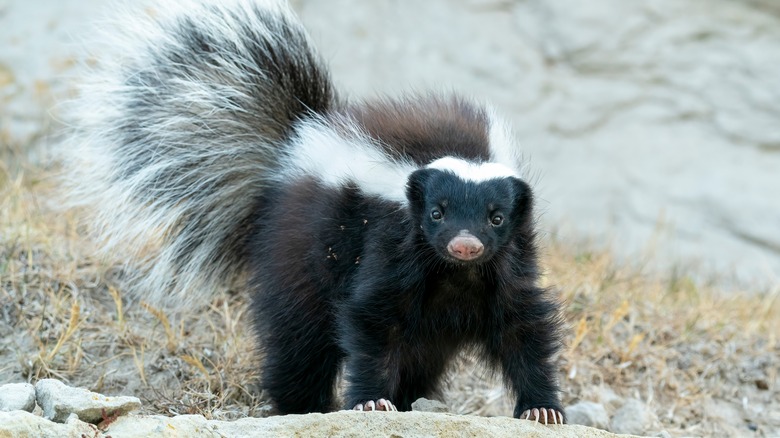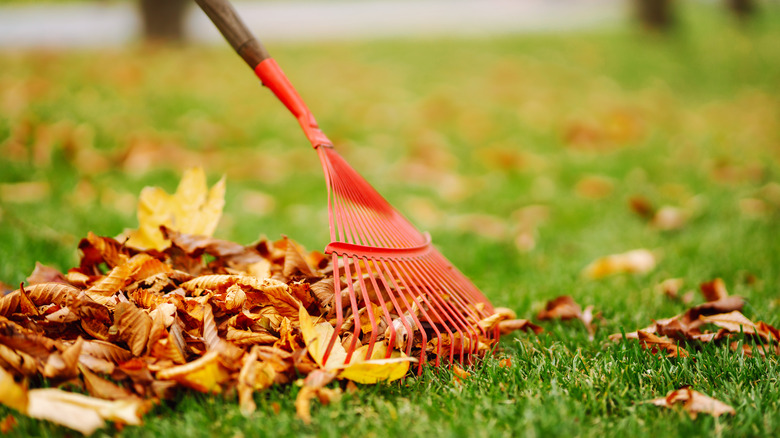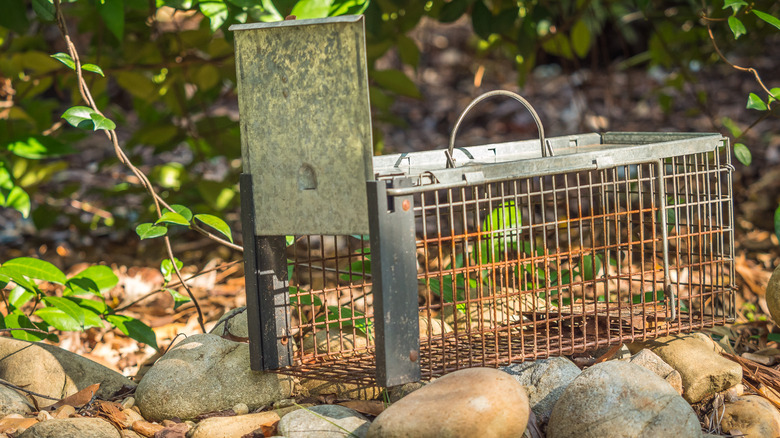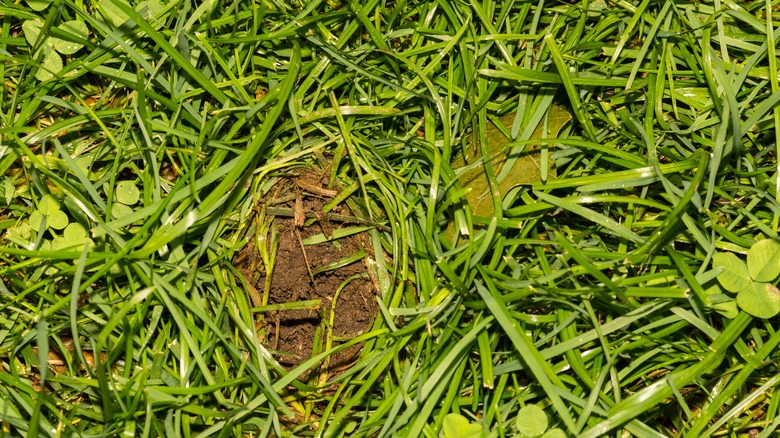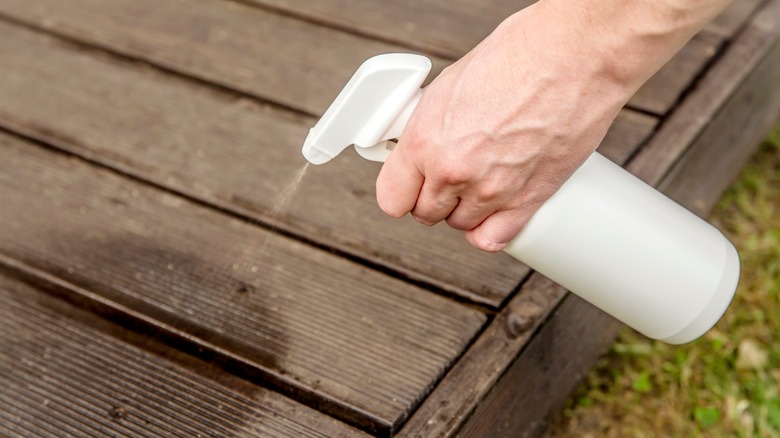Ways To Get Unwanted Skunks Out Of Your Yard
We heard you were raising a stink over a particular critter, so we got the team together to show you a few tried-and-true, humane ways to get unwanted skunks out of your yard. Let's get started, shall we? Skunks are cat-sized mammals in the family Mephitidae. They are easily identifiable by their black bodies and unmistakable white stripes that extend from their backs to bushy tails. Unlike their depiction on screens, they are, in fact, mild-mannered and easy-going nocturnal creatures that mostly keep to themselves.
They will only spray that strong, fetid liquid from their anal glands if they are rabid or when they or their young feel threatened or cornered. Even at that, The Humane Society of the United States says they will give off a series of warning signs before the big showdown, including "stamping [their] front feet, a raised tail, hissing...[and] a characteristic handstand." But that is not to say these creatures are completely innocent. A surfeit of skunks will, among other things, destroy your garden, burrow beneath buildings, tear up your yard, dig through trash cans, and make life a living hell with their persistent, offensive odor. But the truth is that your yard's ecosystem could benefit from having a skunk or two around since they feed on insects, rodents, and property-destroying pests.
1. Install a motion-activated sprinkler
Even though skunks are confident opportunists who waddle onto properties to eat and destroy all that is around them, they are surprisingly jumpy creatures. You can use this trait against them by installing a motion-activated sprinkler in your yard. In some circles, these devices are known as pest-deterrent sprinklers because they drive away wild or unwanted animals such as raccoons, deer, rabbits, or skunks from your yard or vegetable garden before they can jeopardize all of your hard work or hurt your pets.
A motion-activated sprinkler features an intelligent sensing technology that activates when it detects motion or heat through its infrared sensors. When the device goes off, it startles the intruder with a burst of water and whirring noise. The sudden chaos is enough to send any unwanted pest scampering. Pro tip: opt for motion-activated sprinklers that have both motion and heat sensors. They are highly sensitive, detecting animals and birds up to 50 feet away, says Pest Strategies.
2. Clean your surroundings
If you deprive a surfeit of skunks of the ideal conditions needed to survive, they will have no reason to hang around. After all, perfectly mowed lawns, well-tended gardens, and clean outdoor spaces are not exactly what pests would consider a sustaining habitat. Start by removing attractants around the house, such as emptying and covering garbage cans, harvesting any ripe fruits and vegetables, and sweeping as often as possible. Trimming overgrown branches and raking leaf litter during fall is another excellent groundskeeping activity to add to your routine.
You should also consider feeding your pets indoors, but if that is not possible, remove their bowls right after they have finished eating outside. Did you know that skunks love feeding on grubs that inhabit lawns and sod? You can cut off their food supply by introducing beneficial nematodes to your lawn, which will get rid of these tiny trespassers naturally, Bob Vila says. To sum up, maintaining clean surroundings is one of the best ways to keep unwanted skunks out of your yard.
3. Light up your yard
As mentioned above, skunks are nocturnal creatures with high sensitivity to light. You can, once again, use this trait against them by installing motion-activated lights or bright LED lights on a timer in your yard. The random flashes of light will not only send them scampering, but also make them think they are in danger due to the sudden change of environment.
There are two primary ways of evacuating a surfeit of skunks from your property using this method, says MYMOVE. First, during the day, position the bright LED lights in areas where they are likely to be nesting, such as under buildings or low, dark areas, for a couple of days. This will interrupt their beauty sleep, prompting them to find a new habitat. The second method involves installing motion-activated lights to scare them whenever they waddle onto your property. While effective, this method can increase your electricity bill significantly, so we suggest opting for solar-powered lights.
4. Purchase a catch and release trap for skunks
Per PredatorGuard, one of the best ways to get unwanted skunks out of your yard is to set up a catch and release trap. You can purchase these devices at your local hardware store. The ideal size is wide enough to allow movement and comfort, but low enough to prevent the animal from lifting its tail to spray. Note that even though this method is highly effective, you may have to take precautionary steps to ensure that you are not sprayed during transportation.
Read the directions on the model before setting up during the day. Place the trap in areas where the skunks are likely to convene, and camouflage it with leaves and dirt. Attach some bait, too, ideally peanut butter, canned sardines, cat food, bacon, chicken, or tuna. After trapping the animal, walk towards it with a blanket while staying within its line of vision so it is aware of your presence; this prevents it from getting scared. Gently cover the trap with the blanket and if your local wildlife control laws allow, release it 10 miles away from your home. If not, contact your local wildlife control center for guidelines.
5. Use the exclusion method to prevent denning
One of the best manners of skunk removal is using exclusion techniques to prevent denning and aid in foolproof eviction. According to The Humane Society of the United States, this method includes locating a skunk den and loosely filling all potential entrances with biodegradable materials such as leaves, crumpled paper, straw, or soil. If the den has residents, you will find the hole reopened and the materials scattered from when the animal pushed its way out.
However, if the den remains undisturbed for at least three nights in a row, it is safe to assume that the hole is empty and can be filled permanently or blocked with an L-shaped footer of welded wire or similar barriers. If the den is occupied, seal up all borders, leaving one open exit point. You may only seal the remaining exit point when you are certain that the animal has abandoned the hole.
6. Mild harassment
As simple as it sounds, mild harassment is one of the most humane ways to get unwanted skunks out of your yard. It works because skunks keep to themselves and do not like to have their space invaded by humans. Per Pest Killed, there are a variety of methods to try. Repack a den hole with newspaper, leaves, soil, or similar biodegradable materials to see if the skunk receives the message and moves elsewhere.
You can also make their dark, quiet denning hole less inhabitable by projecting bright light and noise in that direction. It is crucial to ensure that the skunk or its young is not in proximity when setting up the disturbances. If the animal does not budge, try discouragement methods. Secure all outbuildings so that they cannot wander in, maintain a clean environment, seal up trash cans, set up a skunk trap right outside the den, or sprinkle DIY repellents.
7. Make a homemade skunk repellent spray
Skunks have sensitive noses and we know just the cocktail that will make them think twice before trespassing. We got the recipe from Tips Bulletin and you will be happy to know that the concoction not only irritates the noses of these creatures, but it also works on chipmunks, squirrels, and other yard pests.
Fill a pot with water and add one chopped onion, one tablespoon of cayenne pepper powder, and two chopped jalapeno peppers. Let the mixture boil for 30 minutes and then allow it to cool to room temperature. Remove the ingredients, strain the liquid, and pour it into a spray bottle. Since this skunk repellent spray is 100 percent natural, it is safe for the environment and can be used on anything, including plants, porches, chicken coops, and fences. For best results, spray your yard every three to five days, or after a rainfall.
8. Try DIY natural home repellent mix
While on the subject of scents that skunks find offensive, let us mention a few more DIY formulas you can use to explore the various ways to get the unwanted pests out of your yard. According to Pest Pointers, the following scents can repel skunks by irritating their sinus cavities. To start, you can try placing rags or cotton balls saturated with ammonia in strategic locations or mix freshly ground black pepper with capsaicin and spread it around your yard.
For options that are more tolerable to humans, you can apply peppermint oil at the entrances of skunk dens, or sprinkle citrus peels throughout your yard. Make sure to push them into crawl spaces, under decks, and suspected dens. You can also spray concentrated vinegar around your property line and hard surfaces such as house siding, deck, and patio, though not on plants. If you use a mixture of vegetable oil and castor oil, however, feel free to spray away. As recommended previously, reapply your preferred formula every three to five days, or after it rains.
9. Hire a professional
If you have tried the aforementioned tips and cannot seem to protect your yard from skunks, you may have no other option but to call in the experts. Though more costly than the DIY methods mentioned here, it is the most effective and foolproof way to remove skunks from your property. A reputable pest control company also comes in handy if there are kits on your property, or you are dealing with an aggressive skunk. They have the license, protective equipment, and training needed to handle rabid, aggressive, stubborn, or elusive skunks, World Birds notes. They may also have helpful advice to offer regarding how to prevent reinfestation.
You may also benefit from researching your local laws to see how to deal with skunks. Depending on a number of factors, wildlife laws can vary drastically from state to state. In some areas, the local wildlife control agency handles the situation at no cost to the property owner.
